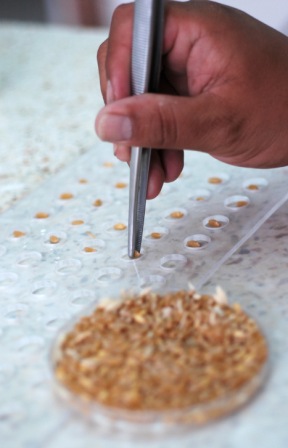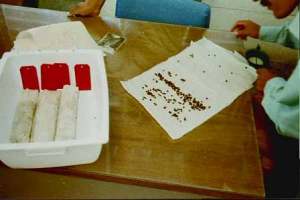Viability of maize genetic resources
Contributors to this page: CIMMYT, Mexico (Suketoshi Taba, Bonnie J Furman), with inputs also received from IITA, Nigeria (Dominique Dumet), EMBRAPA (maize and sorghum genebank), Brazil (Flavia Teixeira), USDA (ARS/NC7, ISU), USA (Mark Millard).
|
Contents: |
Seed viability (percent of germination) of accessions is the most critical factor for seed distribution from the genebank and for new cycles of regeneration. The initial germination test of seed lots of new introductions or seed increased in nurseries is conducted after the seed is dried to the optimal moisture content (6-8%). Once in storage, the first monitoring of seed viability is conducted after ten years of storage in the active collection; then, after every five years as recommended by the standard germplasm bank operation guidelines (FAO/IPGRI 1994).
Laboratory methods

Preparing germination tests using a counting board on |
|
|
The determination of germination percent (%) should be performed with seeds that are dried and cleaned. It is recommended to follow the ISTA rule to count the seeds that have normal and abnormal germination after four and seven days to determine the percent of germination.
Type of test
-
CIMMYT method:
- Seeds are scattered in counting boards of various sizes which are placed on wet filter paper (grade S-915-A, 90 g per square meters) of 35 x 17 cm.
- The wet paper with the seeds is then rolled and placed in a germinating tray with sufficient water in the bottom. One side of the filter paper is folded with a 1-1.5 cm margin before rolling it up with the seeds.
- The folded side of the filter paper is dipped in the water in the tray to help absorb water for germinating seeds.
-
IITA method:
- Germination paper of Seedburo K-22 is effectively used with sterile distilled water.
- There are also other ways to set up the seed germination effectively, click here for more information.
Number of seeds and replicates
- The seed bank curator should use at least two replicates of 50 seeds per set, depending on the seeds, labour and facilities available.
- Genetically heterogeneous populations may need 200 seeds to determine % of germination.
- Homozygous inbred lines may need fewer seeds (50-100) to estimate % germination.
Pre-treatment
-
Both Teosinte and Tripsacum caryopsis, the wild relatives of maize, have hard fruit cases.
- Seeds of these species should be germinated by pre-treatment in hydrogen peroxide for 12-24 hours to help diffuse oxygen into the embryo.
- The caryopsis should be immersed in diluted antiseptic commercial grade hydrogen peroxide solution (3.5%) before germinating.
Media
- Use as many as 80-100 germinating filter rolls with 50 seeds each, placed vertically in a plastic tray (14 cm height x 27 cm width x 37 cm length).
Temperature
- The tray should be placed in a germination chamber at 25oC.
- The chamber temperatures can be monitored by a data logger in the germination room.
Light
- 12 hours’ light and 12 hours’ dark conditions.
Duration of test
- One week.
Other
- The accession or introduction ID number and the replicate number should be written on the dry filter paper (substrate for the seed germination) with a thick lead pencil (Design Ebony) or other types of markers for identification of the seed lots.
- The seedlings should be evaluated on the substrate on the 4th day and 7th day, counting normal, abnormal seedlings and un-germinated seeds .
- When there is a large difference between replicates in terms of germination percentage, then a second test should be done to confirm the results.
Recording information during viability testing
The following information should be recorded for each testing step:
- Accession number (number).
- Introduction ID number (number).
- Collection name, pedigree (name, pedigree).
- Seed origin (field book, location, year, plot number).
- Initial germination (%).
- Current germination (%).
This routine checks are very important to maintain the genebank operation in perpetuity. The seed accessions should be constantly available to the users.
Methods
- The genebank curator should regularly monitor seed quantity and seed viability, in addition to ensuring the storage conditions (relative humidity and temperature) of the seed vaults.
- Safety from vandalism and robbery should also be monitored in the genebank’s operations.
- The curator should monitor the inventory of the seed accessions for percentage of germination once a year.
- Percentage of germination should be updated in the genebank database management system when the seed accessions are utilized.
-
When percentage of germination falls below critical levels (85%), seed should be regenerated.
- The germplasm accessions that are well-adapted to the regeneration sites can be readily regenerated and seed increased.
- The accessions not adapted at the genebank’s regeneration sites need a special arrangement with the collaborating genebanks that can regenerate them (consult the Regeneration guidelines for maize for more details).
Monitoring intervals
Routine monitoring is necessary to ensure viability of seed accessions in both the base and active collections. It is important that seeds be constantly available to users.
- Seed viability should first be monitored after ten years of storage with subsequent monitoring at intervals of 5-10 years. It should be noted that seed viability in the base collection is expected to last longer than that in the active collection and thus monitoring intervals can be longer.
Critical germination level
Seed viability is necessary to ensure a sufficient sample size of accessions for the maintenance of genetic integrity over many regeneration cycles. Seed viability is critical to avoid a population bottle neck of accessions during storage.
- The critical germination level is set at 85%, based on the initial seed viability of 100%..
- The germination of older seeds in the field is expected to be lower (as low as 50%) that the germination percentage revealed by viability testing.
- It is preferable to regenerate the germplasm accessions before reaching a percentage of germination as low as 65%.
- In the case of inbred lines, germplasm should be regenerated before seed viability falls below 80%.
Recording information during storage monitoring
- Accession number (number).
- Introduction ID number (number).
- Collection name, pedigree (name, pedigree).
- Seed origin (field book, location, year, plot number).
- Initial % of germination (%).
- Date of initial seed germination (date).
- Current % of germination (%).
- Dates of monitoring % germination (dates).
- The initial amount of seed stored (grams or number).
- Date of the initial storage (date).
- The current amount of seed stored (grams or number).
References and further reading
Berthaud J, Savidan Y, Barré M, Leblanc O. 1997. Tripsacum. In: Fuccillo D, Sears L, Stapleton P, editors. Biodiversity in Trust. Cambridge Univ. press.
Ellis RH, Hong TD, Roberts EH. 1985. Handbook of seed technology for genebanks volume I. Principles and Methodology. Handbooks for Genebanks no. 2. International Board for Plant Genetic Resources, Rome. http://www.bioversityinternational.org/index.php?id=19&user_bioversitypublications_pi1[showUid]=2405.
FAO/IPGRI. 1994. Genebank standards. Food and Agriculture Organization of the United Nations, Rome and International Plant Genetic Resources Institute, Rome. Available in English, Spanish, French and Arabic.
Hanson J. 1985. Procedures for handling seeds in genebanks. Practical manuals for genebanks no. 1. International Board for Plant Genetic Resources, Rome. HTML version available from: http://www2.bioversityinternational.org/publications/Web_version/188/.
International Seed Testing Association ISTA. 1993. International rules for seed testing. Seed Science and Technology 21, Supplement.
Justice OL, Bass LN. 1978. Principles and practices of seed storage. Agriculture handbook no. 506. U.S. Government Printing Office, Washington D.C.
Taba S, van Ginkel M, Hoisington D, Poland D. 2004. Wellhausen-Anderson Plant Genetic Resources Center: Operations Manual, 2004. El Batan, Mexico: CIMMYT. Available here.
Taba S. 1997. Teosinte. In: Fuccillo D, Sears L, Stapleton P, editors. Biodiversity in Trust. Cambridge Univ. press. pp 234-242.
Walters C, Wheeler LM, Grotenhuis JM. 2005. Longevity of seeds stored in a genebank: species characteristics. Seed Science Research 15:1-20.
Warham EJ, Butler LD, Sutton BC. 1996. Seed testing of maize and wheat: A laboratory guide. CIMMYT, Mexico and CAB International, UK.
Comments
- No comments found






Leave your comments
Post comment as a guest